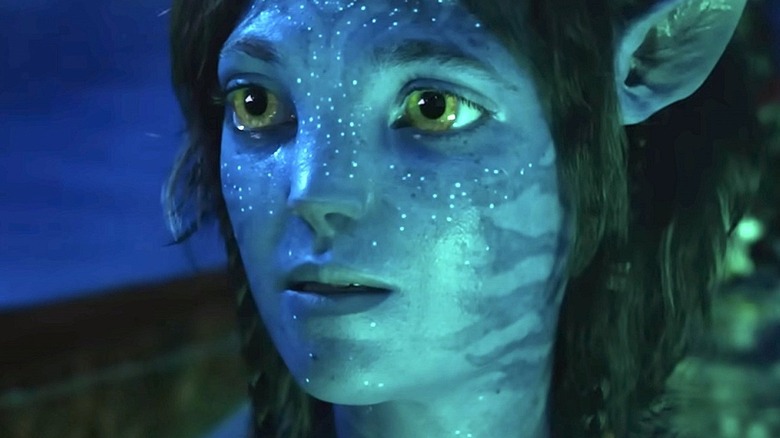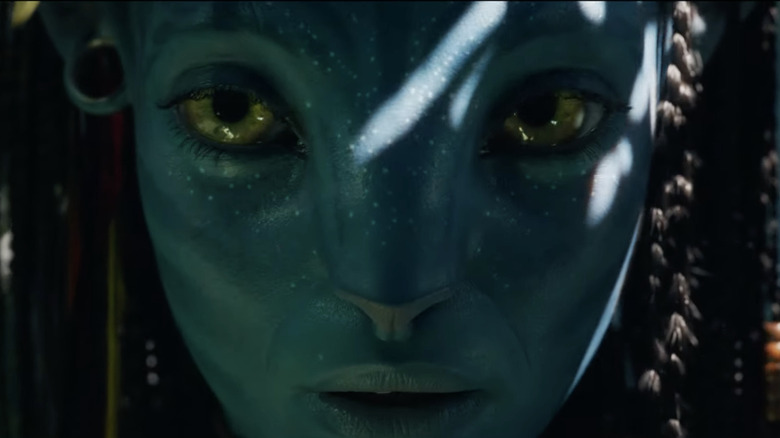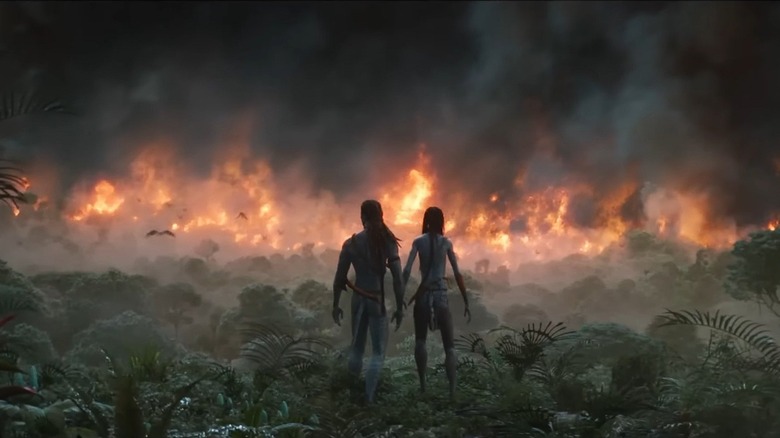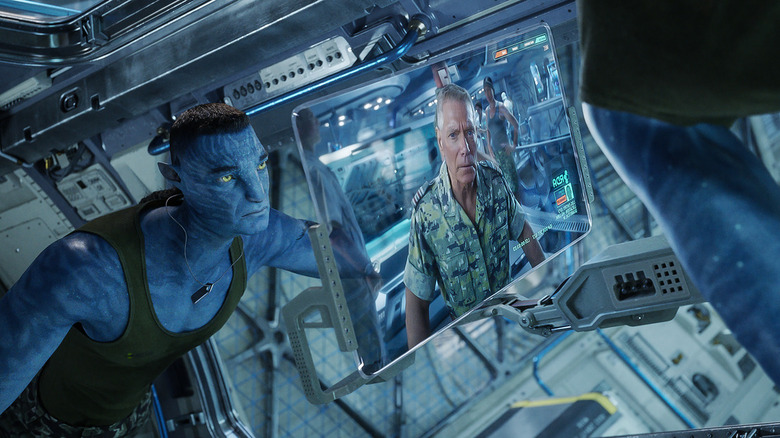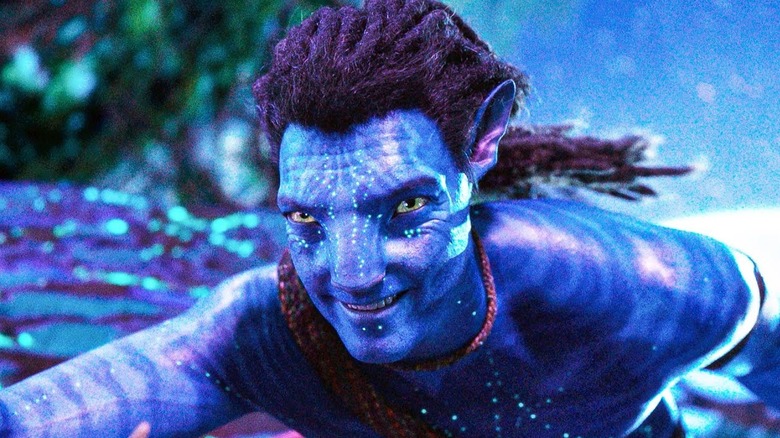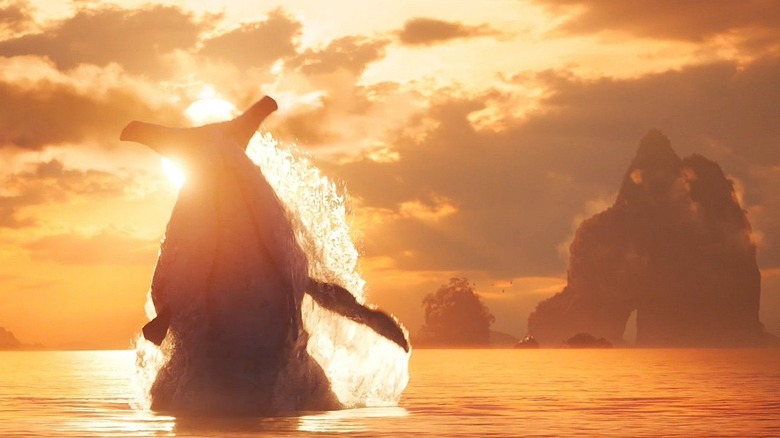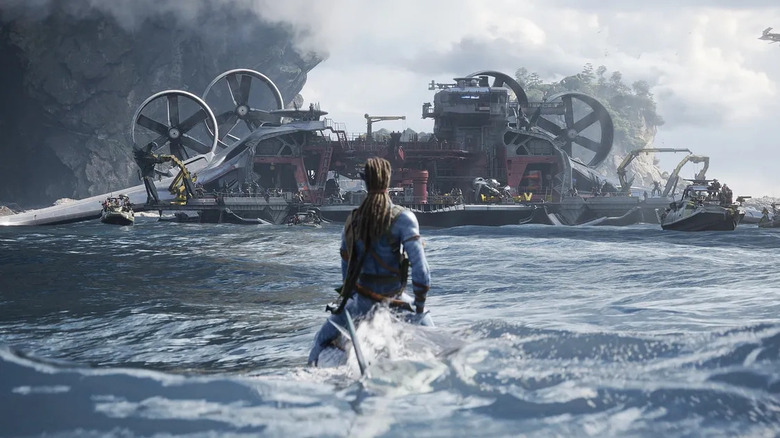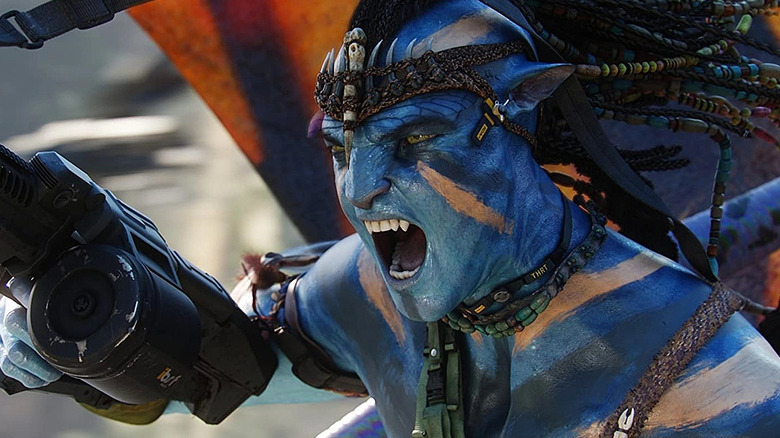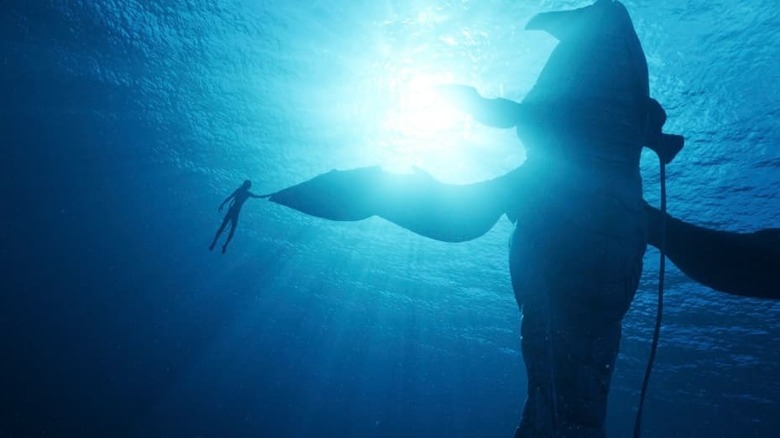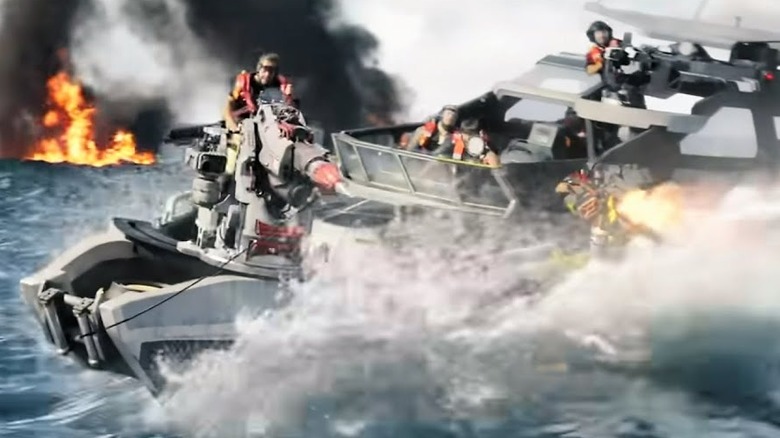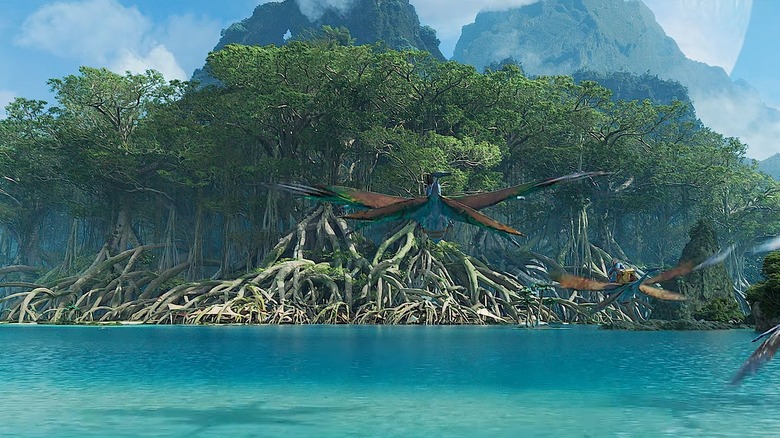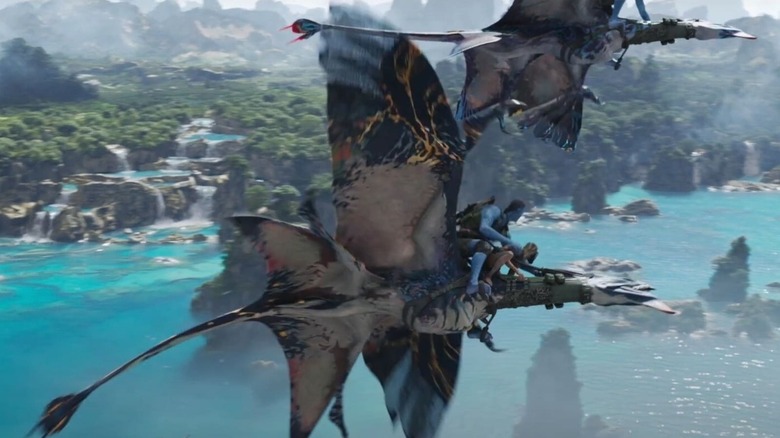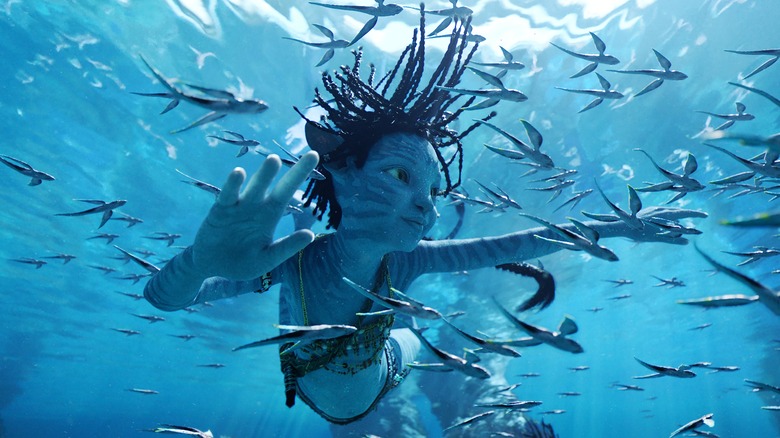Avatar: The Way Of Water's 12 Most Visually-Stunning Moments, Ranked
With 13 years, hundreds of millions of dollars, and 192 minutes of runtime to work with, "Avatar: The Way of Water" was always going to be even more spectacular than its groundbreaking predecessor. It sets a new standard for how immersive and transporting a film can be, doing so with as many gorgeous and intimate scenes as it has heart-pounding battle sequences. The sequel trades labs and floating mountains for director James Cameron's favorite environment — water. The fact that "Avatar 2" can render its alien moon ocean so beautifully for such a sustained period is one of the film's greatest accomplishments. Just as Pandora's bioluminescent forests were like nothing audiences had ever seen before, its glowing seas give fans a new and previously unimaginable viewing experience.
However, that viewing experience won't be the same for everybody. Moviegoers can see the sure-to-be blockbuster in 3D, XD, IMAX, or standard definition. It was produced with a variable frame rate that occasionally switches to 48 frames per second (a style that Peter Jackson's "The Hobbit" trilogy utilized), which not all theaters will be able to display. This means that, depending on consumers' available choices, "Avatar: The Way of Water" could play like anything from an impressive traditional movie to a video game projected on a big screen to a cutting-edge amusement park ride.
Still, regardless of the specs of your cinema, the movie boasts plenty of impressive visuals. Here are the moments in "Avatar: The Way of Water" that stunned us the most.
12. Neytiri's face
Since there isn't any human business to get out of the way in "Avatar 2," we start by catching up with the Sullys, who've been busy growing their family. Jake (Sam Worthington), now fully and permanently Na'vi (despite his extra finger), has gotten new dreadlocks and bulked up a bit since he ran the military out of town. He has two natural-born sons, a baby girl, and an adopted daughter, Kiri, who was born of pregnant Grace's Avatar. For a moment, the film stops on shots of their faces in close-up, particularly one of Neytiri (Zoe Saldaña) that's perfectly symmetrical. These early glimpses of the Sully family's life, and especially these detailed shots of their faces show just how far the performance motion capture technology Cameron uses has come in the last 13 years.
As impressive as the Na'vi were in "Avatar," they still appeared to have been somewhat copied and pasted into backdrops at times, and their movement — including tiny movements like squints and smiles — weren't always entirely smooth and believably real. The Na'vi in "Avatar: The Way of Water" don't just look better integrated and more realistic. They look hyper-real, almost as if there is a reality out there in space that's crisper, clearer, more colorful, and more high-resolution than our own could ever be.
11. Pandora burns again
In the prologue, we learn that Jake, Neytiri, and their brood have enjoyed about 10 years of domestic contentment. During this time, they've been lulled into blissful ignorance as to whether the sky people might ever return. However, return they do. Jake is aware enough of the finer points of interplanetary transportation that he recognizes a brightly burning star for what it really is — RDA ships. In a surprise cameo, Edie Falco as General Frances Ardmore fills us in as to what's been happening on the human end for the last decade. It turns out Earth is officially dying, and she's been sent to terraform Pandora to make it a suitable home for the human race. Jake and Neytiri don't know this yet (in fact, the Na'vi never find out RDA's true motivation) — all they see are helicopters and mechs burning down their beloved forests.
A deeply distraught Neytiri cries out as she did at the end of the first "Avatar" upon seeing history repeat itself. Though what's happening is devastating, the visual effects are astounding. The frame lingers on a few large trees as they are engulfed in flames. The contrast between the lush and neon greenery, the violent fire, and the plumes of dark smoke from which panicked Na'vi and banshees emerge is both heartbreaking and heart-stoppingly well executed. It's even more effective because we don't expect an action set piece on this scale so early in the movie.
10. Avatar Quaritch leans the ropes
When news broke that Stephen Lang had been cast in "Avatar: The Way of Water," fans justifiably wondered how that was possible. His character, Colonel Miles Quaritch, died at the point of Neytiri's arrow in that movie's climactic battle. Lang is back, this time in the form of a Recombinant — an Avatar spy without the need for a human to control it. Quaritch's memories had been copied to a hard dive-like device, sent back to scientists on Earth, and uploaded as a type of consciousness into this blue ten-foot-tall body. It sure seems like Quaritch being resurrected as the thing he hates is setting him up for a Darth Vader arc in future "Avatar" installments, but for now, it's fun to watch Quaritch prepare for his mission in the first act.
As the team is about to arrive on Pandora, Quaritch the Recombinant is let out of a pod-like chamber. He floats around in zero gravity for a while before finding a high-tech tablet-like device that would make Tony Stark jealous. A video diary recorded before human Quaritch's death explains to the reborn Quaritch who he is, how he came to be, and what he's meant to do. It's a cool sci-fi scene in and of itself, but throughout, the camera flips and spins as if it's suspended in zero gravity, making it so much cooler. So does the well-calibrated 3D, which makes the audience feel like they're floating, too.
9. Date night, Na'vi style
Even 11 years into mating for life, Jake and Neytiri still clearly have the hots for each other. At one point, Jake — busy clan leader and father of four — narrates about how much he looks forward to date night. For the Na'vi, the height of romance is side-by-side banshee flying just before the eclipse, when Pandora's blacklight qualities are at their most perceptible. "Avatar" has shown us both banshee flying and bioluminescence multiple times before, but never together.
Jake and Neytiri each take to their bonded banshee (Ikran to the Na'vi) out for a spin. Apparently, Neytiri has met and won over a new Ikran since hers was killed in battle near the end of "Avatar." The sequel gives us about a minute of our favorite blue lovebirds carefree as they careen around the Hallelujah Mountains and through Pandora's dense, lit-up flora. It makes all the difference that this isn't an escape or a mid-air melee. The audience can relax (a major theme of the movie) as the couple's pleasure ride lets them see Pandora at its most unusual and striking from this new fast-moving perspective.
8. Payakan's flashback
"Avatar: The Way of Water" has more of everything, including subplots. The one that dominates the middle third of the movie is troublemaking son Lo'ak's (Britain Dalton) relationship with the outcast bull Tulkun, Payakan. A subplot within this subplot is the mystery of how Payakan lost one of his fins. The first few times Lo'ak and Payakan communicate, the whale-like creature is reluctant to let the Na'vi boy in on his secret. A Tulkun subtitle tells us it's "too painful" to share. Eventually, Lo'ak earns Payakan's trust, and it becomes necessary for the supposedly killer Tulkun to tell the truth.
Payakan opens his mouth — made up of what look like hard-shelled flower petals — and lets Lo'ak inside. Unexpectedly, he closes those flaps and traps the boy in. His parents are worried, but Ronal (Kate Winslet) stops them from intervening. Payakan offers Lo'ak his version of a glowing, tentacle-y tail, and the two bond. Suddenly, the Na'vi can see the Tulkun's memories. He didn't kill other Tulkuns and Na'vi, as is the assumption that got him banished from the community. He tried to fight back against the humans and lost.
The flashback is brief and of an action sequence than a montage. However, the images of limp, dead Tulkuns and Na'vi floating in flaming water littered with ships and shrapnel — along with the tragic story they convey — affect the audience as much as the young Na'vi.
7. The RDA whaling vessel sinks
Just like 2009's "Avatar," 2022's "Avatar: The Way of Water" ends with a battle between the Na'vi and the humans that's so monumental in scale and length that it's hard to call it an ending. The nearly hour-long sequence aboard and around a commandeered RDA whaling vessel is practically its own movie. Since it's so involved, it's a fool's errand to pick out a single frame or an isolated incident that shocks and awes more than the others. One of the better action set pieces within the epic last act might have reminded viewers of another iconic moment from James Cameron's filmography — the sinking of the Titanic.
Here, an enormous "sea dragon" takes a fatal hit from Payakan, who bursts out of the water and lands on deck with his many-ton Tulkun body. Jake is about to surrender to Quaritch to save his kids, but the Pandoran whale gives him the chance to attack instead. There are minutes upon minutes of intensity that rival or surpass any action movie of the last 10 years in the scenes that follow, but the tension really ramps up when everyone realizes the whaling vessel is going to sink. Structures begin to break apart. Water gushes into hallways. Characters slide along surfaces and are sucked into vents.
As in "Titanic," the sinking ship in "Avatar: The Way of Water" manages to feel claustrophobic and like the most bombastic action sequence ever at the same time.
6. The Omaticaya insurgency
Though "Avatar: The Way of Water" ends with its longest and most complex battle, it kicks off (after the dreamy prologue) with one of the franchise's most visually and narratively interesting conflicts to date. A title card tells us that a year has gone by since RDA spaceships reappeared in Pandora's skies. Jake, leader of the Omaticaya, has been organizing guerilla assaults every time General Ardmore's forces breech their perimeter. This time, a high-speed train with a cache of weapons and technology is en route through Omaticaya territory.
The coordinated Na'vi attack begins as they bomb the track, derail the supply train, and loot the wreckage. Jake already has high-powered firearms at his disposal (it's somewhere between cheesy and awesome to see the once-human clan leader fire an automatic rifle while decked out in war paint atop his wild mount), but he's happy to distribute more to the rest of his army. This scene wraps up as Jake's sons disobey him and abandon their lookout positions to join the warriors on the ground, but before the family drama, there's plenty of mesmerizing 3D-enhanced action.
A shot of a sky full of Na'vi warriors on banshees amps up the audience's adrenaline, as do the 3D flame trails of bullets that fly between trees and Na'vi on direhorse and on foot. It feels like Jake's insurgency is going to explode right out of the screen.
5. Lo'ak bonds with Payakan
Lo'ak and Payakan are arguably the main characters of "Avatar: The Way of Water," even though the overarching plot revolves around Jake trying to protect his family while he's unknowingly pushing away his son. After Lo'ak picks a fight with Tonowari and Ronal's kids, quickly getting his older brother Neteyam (Jamie Flatters) involved, Jake makes them apologize and tells them to play nice with the people who've taken them in. Lo'ak tries, but the Metkayina boys are pretty bigoted toward forest dwellers. They lure Jake and Neytiri's second-born son to what they insist is a good fishing spot and, as a sick joke, all but leave him for dead.
Lo'ak realizes he's been tricked seconds before an Akula has him in his sights. The scene in which the boy tries to evade Pandora's version of a shark is terrifying, like something out of "Aliens" or "The Abyss." A fade to black makes it seem as though Lo'ak has drowned, but he's rescued by Payakan, whose back he rests on as he recovers.
The scene that follows, in which Lo'ak helps to remove a harpoon from Payakan's fin and forms a relationship with the blue whale-sized creature, is one of the most beautiful and emotional in all of "Avatar: The Way of Water." The use of light coming through the water, the realism of every splash, and the difference in size between these two "brothers" make these fleeting peaceful moments stand out.
4. The Tulkan hunt
On the other end of the spectrum is one of the most upsetting scenes in "Avatar: The Way of Water." Quaritch and his team learn that Jake and his family might've escaped to Pandora's islands. He forces the cooperation of a whaling expedition and burns down every coastal Na'vi settlement he comes across in an attempt to find Jake. When that doesn't work, he decides to use whale hunting to trap the Na'vi, who Captain Mick says will fight to protect the Tulkun if they hunt too close to their strongholds.
In a gripping but difficult sequence, Captain Mick (Brendan Cowell) pursues Ronal's soul sister, who'd recently given birth to a calf. Morally conflicted marine biologist Dr. Garvin (Jemaine Clement) explains the process to Spider as an enthusiastic Captain Mick educates Quaritch in his methods. After deploying a fleet of boats and submarines armed with sound cannons, darts with floatation devices, and exploding harpoons, Ronal's Tulkun dies and her brain matter is harvested as a human anti-aging substance.
The next hunt doesn't go as well for Captain Mick. When a tracking dart lands in Payakan and the Na'vi come to his rescue, the vengeful Tulkun takes matters into his own fins. He destroys the ship by wrapping the harpoon cord around it and thrashing, resulting in the aerial dismemberment of Captain Mick's arm. These scenes aren't exactly beautiful, but they are no less visually masterful than anything else "Avatar: The Way of Water" has to offer.
3. The Sullys arrive at Metkayina Reef
The exotic, colorful forests of Pandora made a lasting impression on fans of "Avatar." The production design is probably the thing audiences remember most (and most fondly) about the movie. To keep things fresh, Cameron has added to Pandora's worldbuilding with the Metkayina reef, part of a tropical coastal system of Na'vi clans far from Jake and Neytiri's corner of the moon. The reef is exotic and colorful in its own way but with real-world inspirations that inform its look and feel, as was the case with Hometree and its surrounding rainforests.
As the Sully family approaches what they hope will be their refuge, they see misty mountains beset by tree roots that extend into clear green-blue water. Na'vi children play in rocky tide pools that resemble Pandora versions of something humans might see at Yellowstone. Three Brothers Rock protrudes out of nowhere like monoliths from the Pacific Northwest. The Metkayina are loosely based on Indigenous cultures such as the Māori, and production designers have brought their world to life with texture and depth, not only in terms of their natural setting but also in terms of their living quarters, clothing, food, and traditions.
When seen in 3D, viewers might be tempted to get out of their seats and try to bounce around the Metkayina's net bridges or take a bite out of their crystalline fruit. Everything about the reef makes one want to vacation there, but the establishing shots that are both ours and the Sully's first eyefuls of this habitat are absolutely stunning.
2. Jake versus Quaritch on mounts
As "Avatar: The Way of Water" winds down, it might feel like there's no possible way for Cameron to top himself. By this point, we've seen a train heist, a shark attack, and a guy's arm getting ripped off by a magical whale. We've seen more banshees than we can count. We've watched Jake and his family learn to bond and ride with Ilu, and we're no longer blown away by scuffles between arrow-wielding Na'vi and humans in mech suits. Then, for far too brief an instant, Jake Sully and Miles Quaritch engage each other in a fight above the reef waters. Jake is mounted on his Ilu while Quaritch rides the forest banshee he bonded with "the hard way."
On one hand, this is the kind of over-the-top story beat that often gets made fun of in, say, the MCU. What's different about Jake and Quaritch's unfinished duel (it occurs shortly before the war moves to the boat) is that it's an earned moment of rising action that's part of what will be a trilogy-long conflict, and it looks so much better than these kinds of fantasy sky battles usually look.
Na'vi Jake and Quaritch's bodies, as well as those of the banshee and the Ilu, move like real bodies. The image is crisp, colorful, and detailed throughout, as is the background of jutting rock formations and spilling aqua pools. This acrobatic alien fight sequence might be the best use of motion capture and CGI technology in a non-real-world action sequence yet.
1. The girls learn to free dive
Let's be honest, the "Avatar" movies are just as much (if not more) about allowing audiences to visit Pandora as they are about telling a story. So, when that story stops altogether after the Metkayina decides to grant the Sullys refuge so that everybody can just hang out, it's not only fine, it's the best part of the movie. For about the next half hour, we learn to free dive with Tuk (Trinity Jo-Li Bliss) and Kiri (Sigourney Weaver), with Tsireya as our guide and teacher. Sure, the Sullys need to hone these skills if they're going to live among the Metkayina, but this is really an excuse for Cameron to show us what he can do.
The female children take to free diving easier than the boys, mostly because they're able to follow Tsireya's advice and calm their hearts. A majorly chilled-out Tuk and Kiri admire and explore their surroundings, which include schools of Pandoran fish, underwater forests of Pandoran fauna, and nifty butterfly-like creatures that, when bonded with, give one the ability to breathe when submerged. The underwater environments of "Avatar: The Way of Water" and the scenes that take place in them — especially the first one — look so phenomenal they'll likely change filmmakers' concept of what's possible with 3D storytelling.
